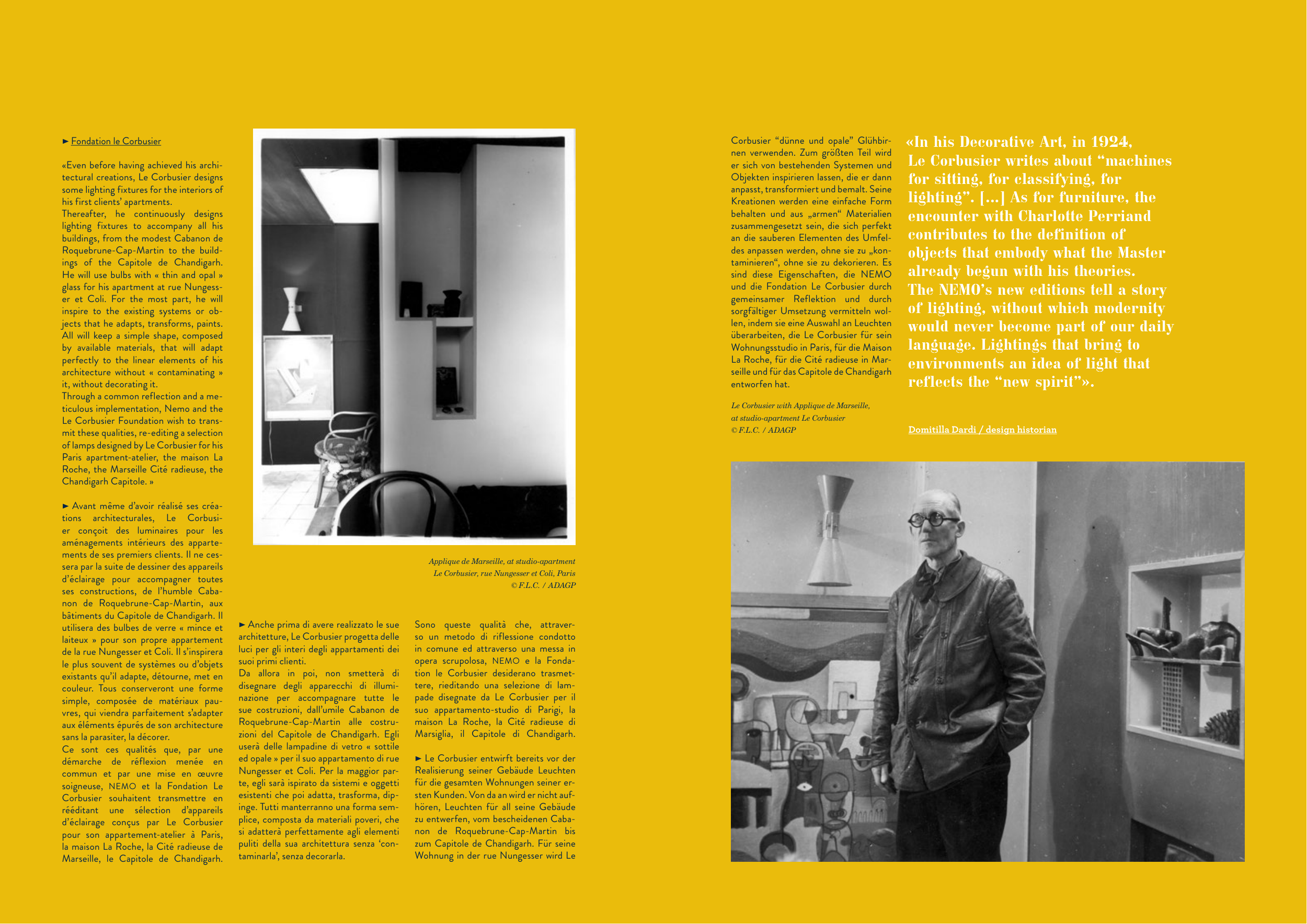v
► Fondation le Corbusier
«Even before having achieved his archi-
tectural creations, Le Corbusier designs
some lighting fixtures for the interiors of
his first clients’ apartments.
Thereafter, he continuously designs
lighting fixtures to accompany all his
buildings, from the modest Cabanon de
Roquebrune-Cap-Martin to the build-
ings of the Capitole de Chandigarh.
He will use bulbs with « thin and opal »
glass for his apartment at rue Nungess-
er et Coli. For the most part, he will
inspire to the existing systems or ob-
jects that he adapts, transforms, paints.
All will keep a simple shape, composed
by available materials, that will adapt
perfectly to the linear elements of his
architecture without « contaminating »
it, without decorating it.
Through a common reflection and a me-
ticulous implementation, Nemo and the
Le Corbusier Foundation wish to trans-
mit these qualities, re-editing a selection
of lamps designed by Le Corbusier for his
Paris apartment-atelier, the maison La
Roche, the Marseille Cité radieuse, the
Chandigarh Capitole. »
► Avant même d’avoir réalisé ses créa-
tions
architecturales,
Le
Corbusi-
er conçoit des luminaires pour les
aménagements intérieurs des apparte-
ments de ses premiers clients. Il ne ces-
sera par la suite de dessiner des appareils
d’éclairage pour accompagner toutes
ses constructions, de l’humble Caba-
non de Roquebrune-Cap-Martin, aux
bâtiments du Capitole de Chandigarh. Il
utilisera des bulbes de verre « mince et
laiteux » pour son propre appartement
de la rue Nungesser et Coli. Il s’inspirera
le plus souvent de systèmes ou d’objets
existants qu’il adapte, détourne, met en
couleur. Tous conserveront une forme
simple, composée de matériaux pau-
vres, qui viendra parfaitement s’adapter
aux éléments épurés de son architecture
sans la parasiter, la décorer.
Ce sont ces qualités que, par une
démarche de réflexion menée en
commun et par une mise en œuvre
soigneuse, NEMO et la Fondation Le
Corbusier souhaitent transmettre en
rééditant
une
sélection
d’appareils
d’éclairage conçus par Le Corbusier
pour son appartement-atelier à Paris,
la maison La Roche, la Cité radieuse de
Marseille, le Capitole de Chandigarh.
«In his Decorative Art, in 1924,
Le Corbusier writes about “machines
for sitting, for classifying, for
lighting”. [...] As for furniture, the
encounter with Charlotte Perriand
contributes to the definition of
objects that embody what the Master
already begun with his theories.
The NEMO’s new editions tell a story
of lighting, without which modernity
would never become part of our daily
language. Lightings that bring to
environments an idea of light that
reflects the “new spirit”».
Domitilla Dardi / design historian
► Anche prima di avere realizzato le sue
architetture, Le Corbusier progetta delle
luci per gli interi degli appartamenti dei
suoi primi clienti.
Da allora in poi, non smetterà di
disegnare degli apparecchi di illumi-
nazione per accompagnare tutte le
sue costruzioni, dall’umile Cabanon de
Roquebrune-Cap-Martin alle costru-
zioni del Capitole de Chandigarh. Egli
userà delle lampadine di vetro « sottile
ed opale » per il suo appartamento di rue
Nungesser et Coli. Per la maggior par-
te, egli sarà ispirato da sistemi e oggetti
esistenti che poi adatta, trasforma, dip-
inge. Tutti manterranno una forma sem-
plice, composta da materiali poveri, che
si adatterà perfettamente agli elementi
puliti della sua architettura senza ‘con-
taminarla’, senza decorarla.
Sono queste qualità che, attraver-
so un metodo di riflessione condotto
in comune ed attraverso una messa in
opera scrupolosa, NEMO e la Fonda-
tion le Corbusier desiderano trasmet-
tere, rieditando una selezione di lam-
pade disegnate da Le Corbusier per il
suo appartamento-studio di Parigi, la
maison La Roche, la Cité radieuse di
Marsiglia, il Capitole di Chandigarh.
► Le Corbusier entwirft bereits vor der
Realisierung seiner Gebäude Leuchten
für die gesamten Wohnungen seiner er-
sten Kunden. Von da an wird er nicht auf-
hören, Leuchten für all seine Gebäude
zu entwerfen, vom bescheidenen Caba-
non de Roquebrune-Cap-Martin bis
zum Capitole de Chandigarh. Für seine
Wohnung in der rue Nungesser wird Le
Corbusier “dünne und opale” Glühbir-
nen verwenden. Zum größten Teil wird
er sich von bestehenden Systemen und
Objekten inspirieren lassen, die er dann
anpasst, transformiert und bemalt. Seine
Kreationen werden eine einfache Form
behalten und aus „armen“ Materialien
zusammengesetzt sein, die sich perfekt
an die sauberen Elementen des Umfel-
des anpassen werden, ohne sie zu „kon-
taminieren“, ohne sie zu dekorieren. Es
sind diese Eigenschaften, die NEMO
und die Fondation Le Corbusier durch
gemeinsamer Reflektion und durch
sorgfältiger Umsetzung vermitteln wol-
len, indem sie eine Auswahl an Leuchten
überarbeiten, die Le Corbusier für sein
Wohnungsstudio in Paris, für die Maison
La Roche, für die Cité radieuse in Mar-
seille und für das Capitole de Chandigarh
entworfen hat.
Applique de Marseille, at studio-apartment
Le Corbusier, rue Nungesser et Coli, Paris
© F.L.C. / ADAGP
Le Corbusier with Applique de Marseille,
at studio-apartment Le Corbusier
© F.L.C. / ADAGP


